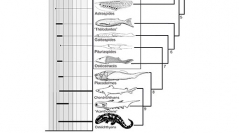

 Comptes Rendus Palevol
8 (2-3) - Pages 209-219
Comptes Rendus Palevol
8 (2-3) - Pages 209-219Vertebrates are one of the few metazoan taxa, which display a well-corroborated phylogenetic pattern, a good and anatomically informative fossil record, and a relatively slow ontogenetic development. They are thus a favourite taxon for illustrating evolution as a historical process, although the stem of the vertebrate tree remains poorly documented by fossils, except for some Early Cambrian forms. Therefore, the characterization of the vertebrates now rests essentially on a small number of developmental characters, mostly involved in the rise of the skull, and whose precursors may occur in other chordates. The tree of the crown-group vertebrates also shows some major morphological gaps due to early extinctions, but a number of Palaeozoic stem gnathostome taxa helps in documenting the agnathan-gnathostome evolutionary transition. However, stem cyclostomes remain elusive.
Vertebrates, Chordates, Phylogeny, Fossils, Morphological gaps, Evolutionary transitions